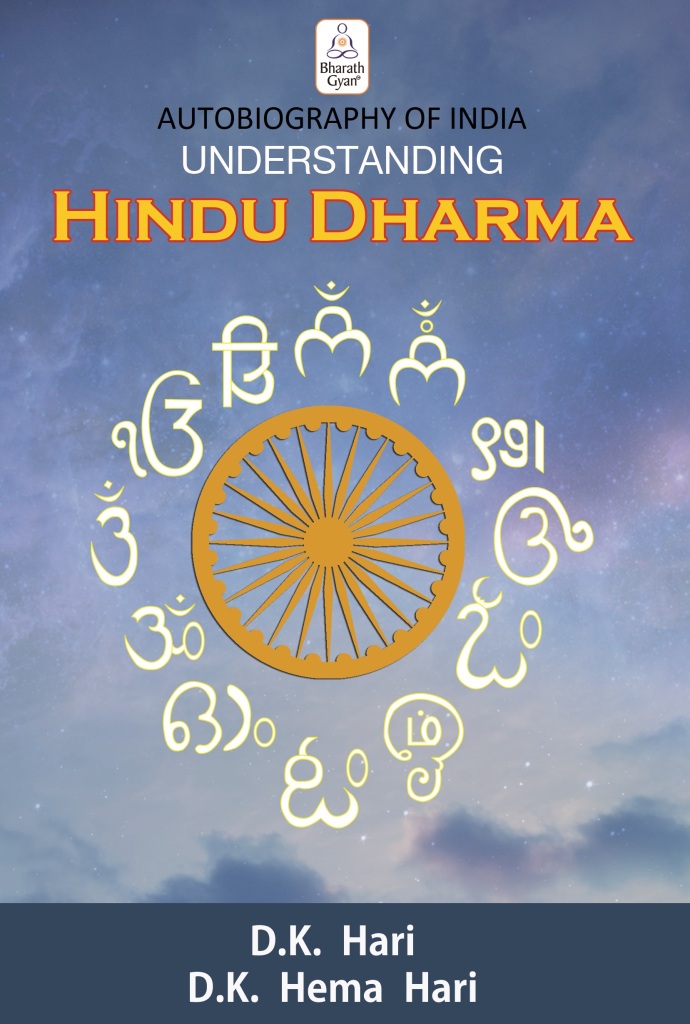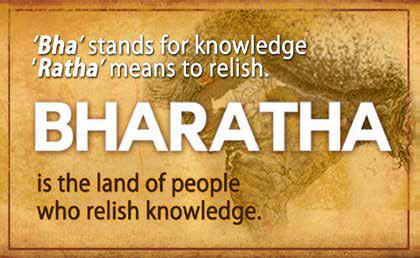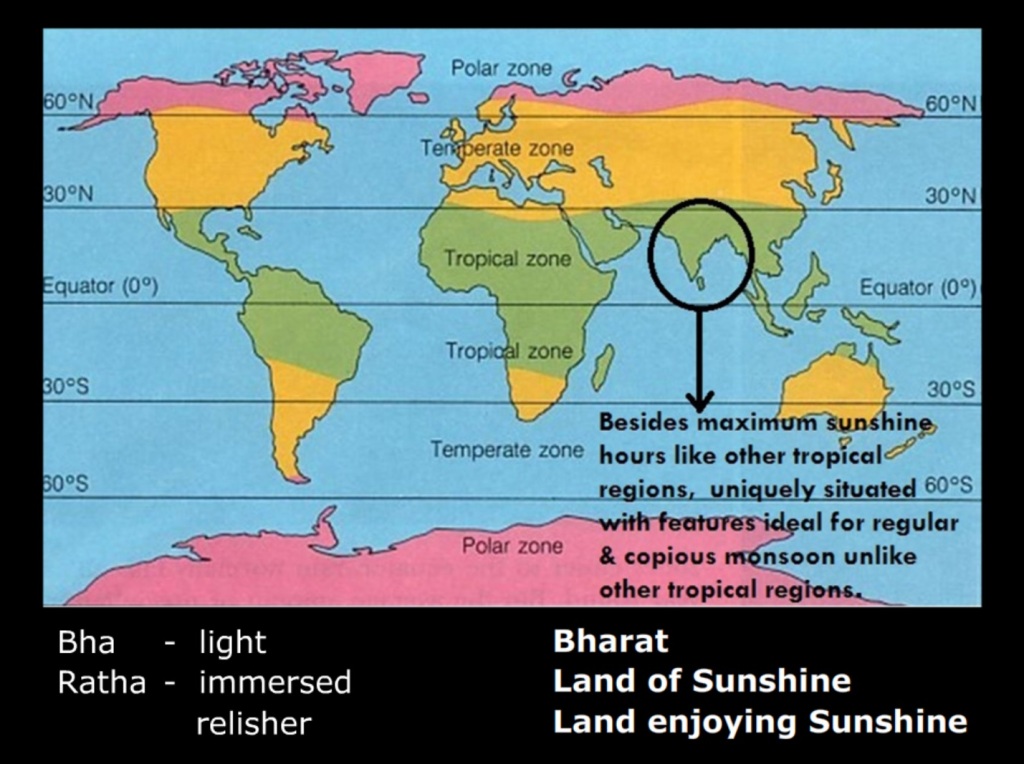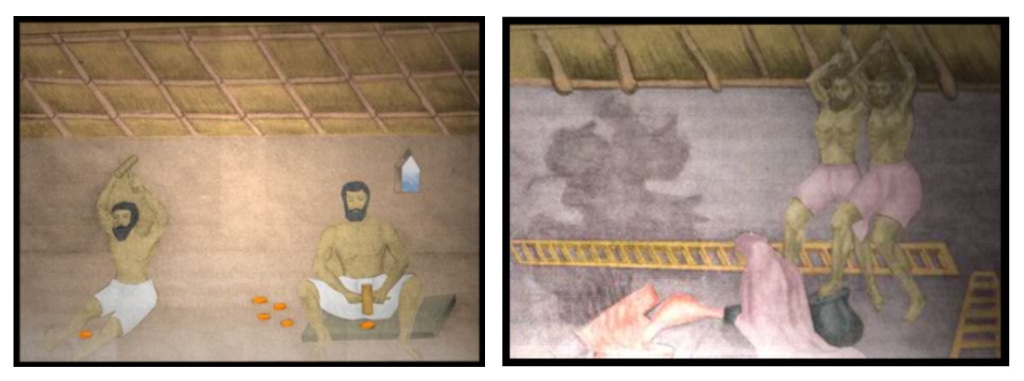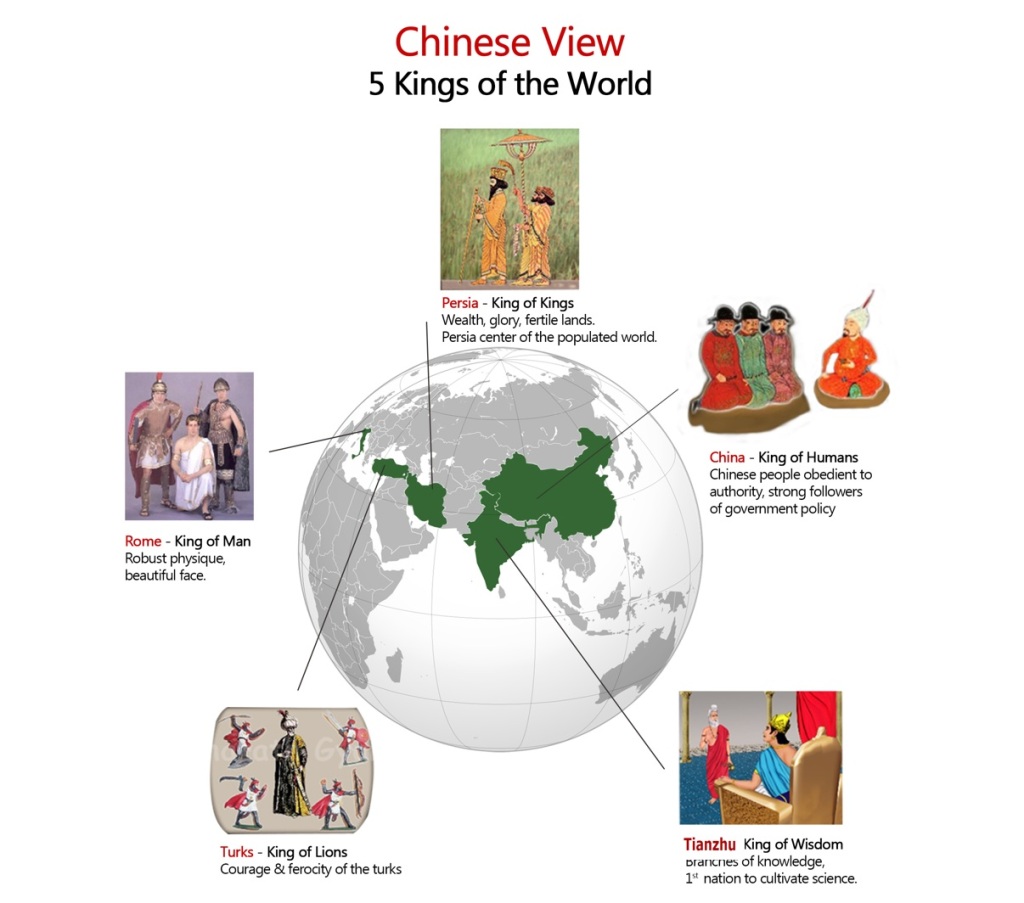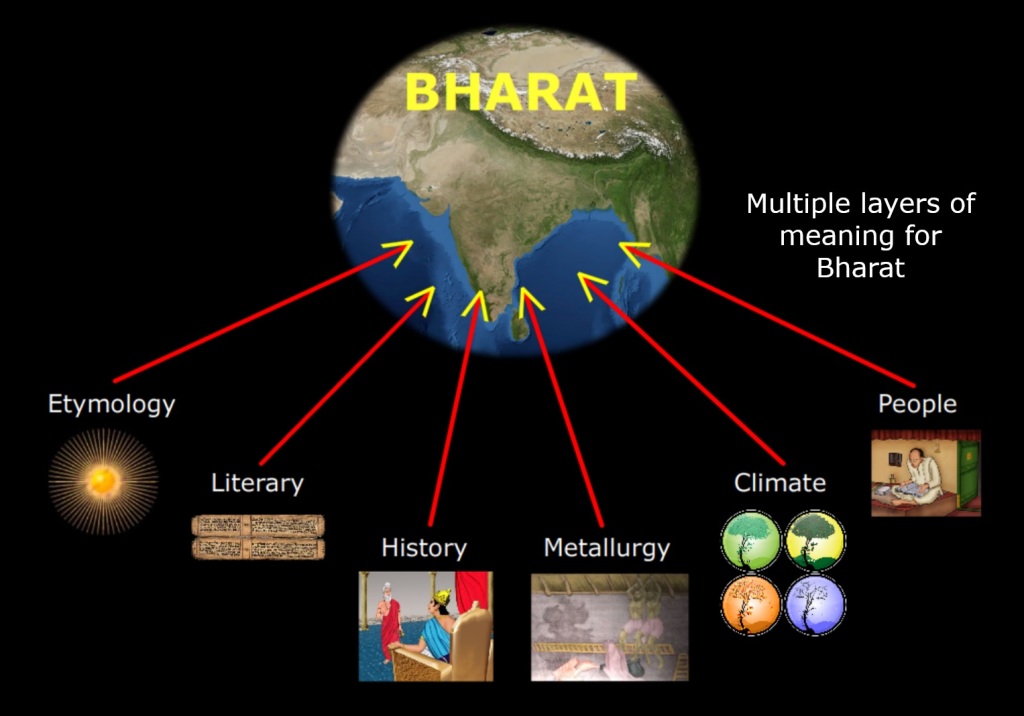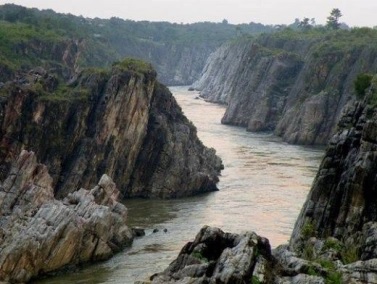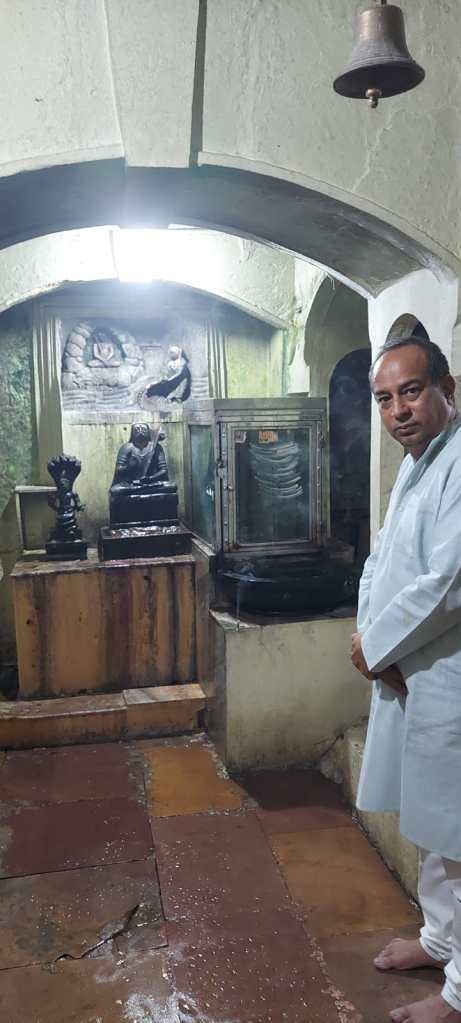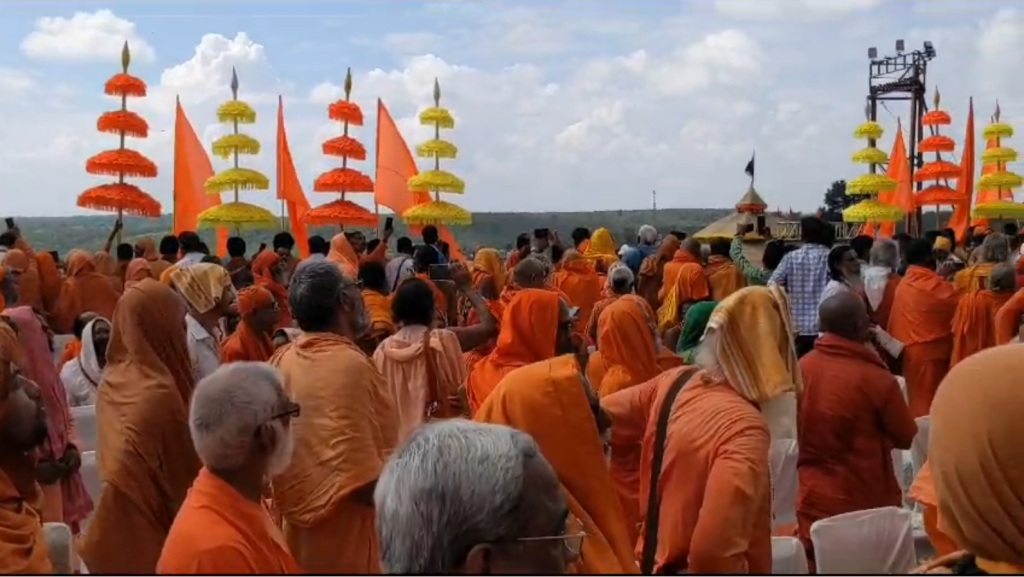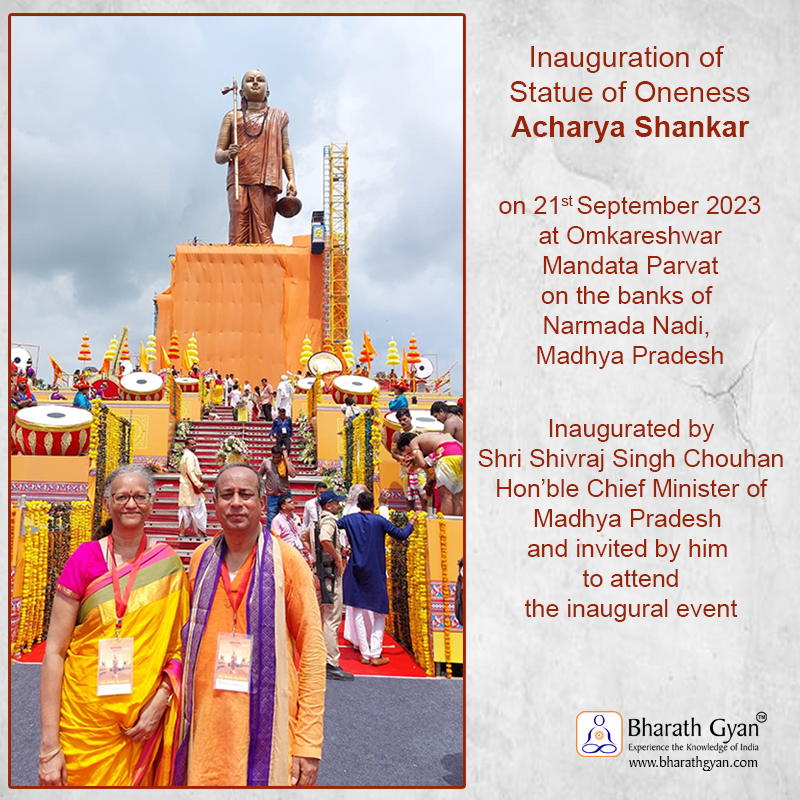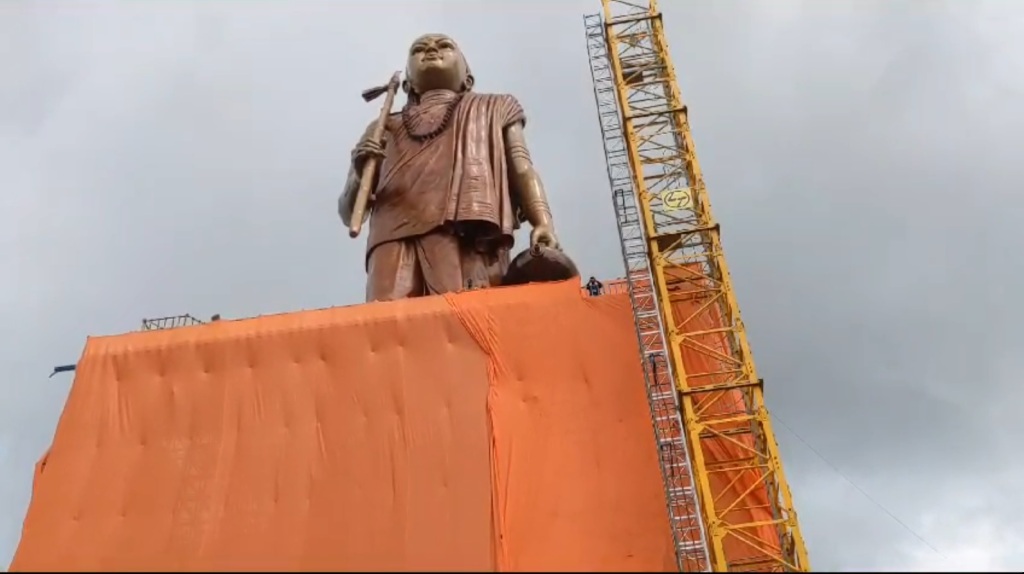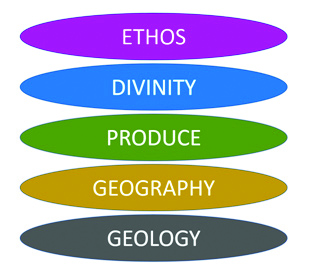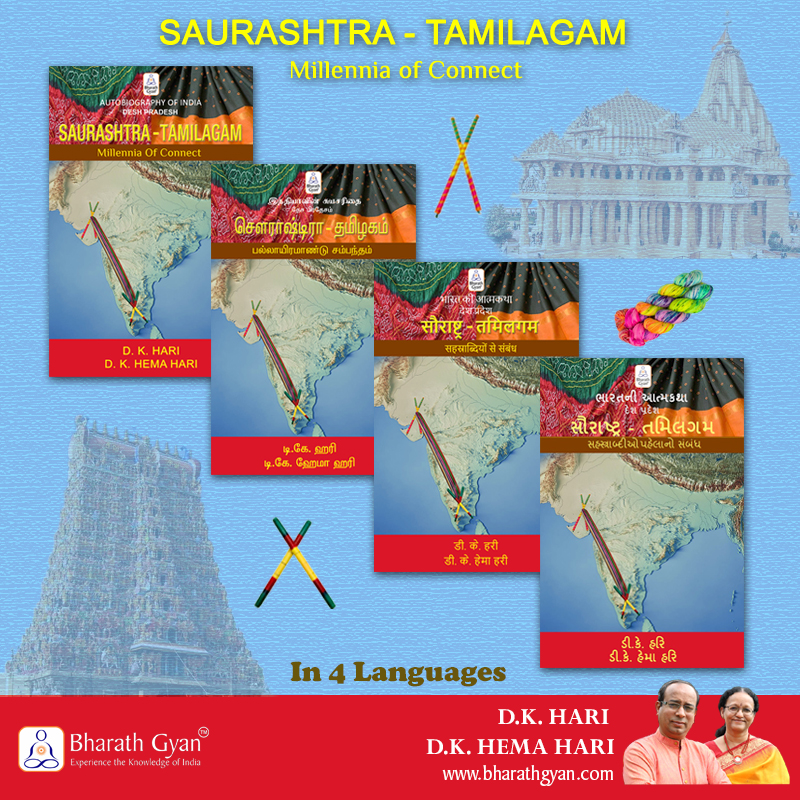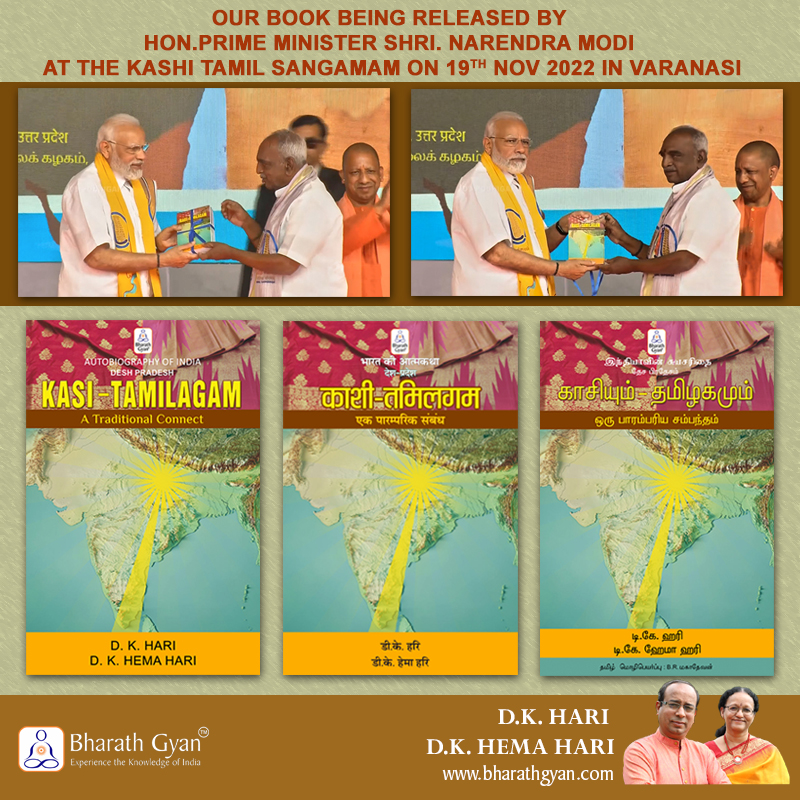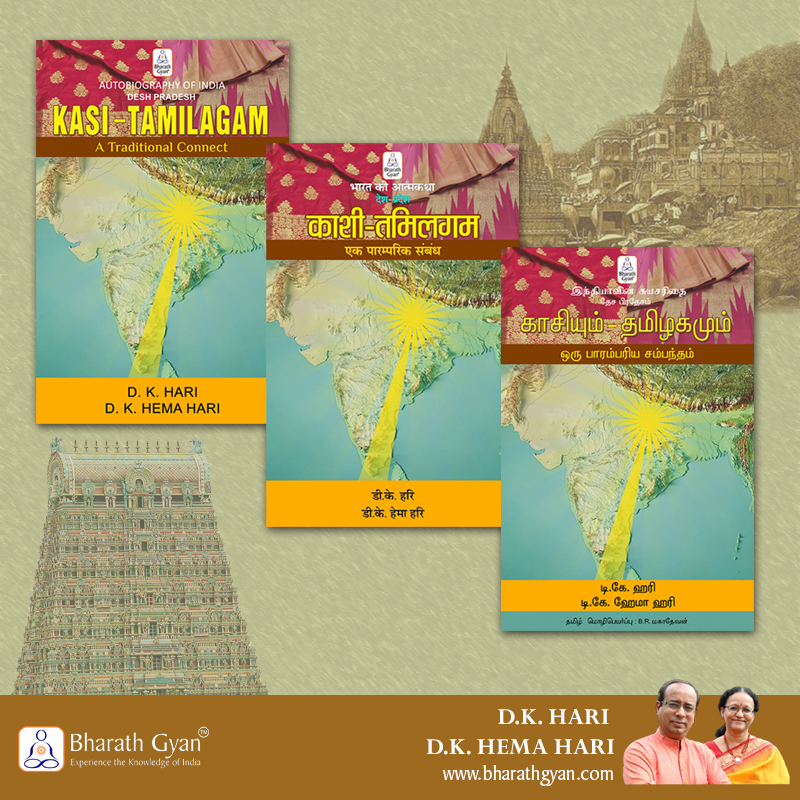Vandanamu Raghunandana,
Setubandhana Bhaktachandana, Rama!
Respects to the scion of Raghu
Builder of Setu (the bridge), Delight Of Devotees, Rama!
These are the opening verses of the song in praise of Sri Rama, composed by Sant Thyagarajaswami, an ardent Bhakta, devotee of Bhagawan Sri Rama. Sant Thyagarajaswami was born and lived in Tiruvaiyar in Tamil Nadu, singing paeans in Telugu on Sri Rama, His traits and His deeds.
The above song describes Sri Rama as the Builder of Setu.
Rama – A Builder Of Bridges – One Who Connects
Rama as a builder of Setu can be seen in more ways than, as one who bridged the shores of the island of Lanka and the shores of the Indian peninsula with a physical bridge, the Rama Setu / Nala Setu alone.
Rama also represents the invisible threads of sentiment, memories, traditions that have kept the people of Bharat connected and bound together, as a civilization that has been conducting itself by the values exemplified by Sri Rama Himself.
It will be interesting to note how the words bond, band share a phonetic as well as semantic connect with the Indian word “bandhan” which means to bridge, bind, bond. i.e to connect with a purpose to keep secure, intact. The act of Rakshabandhan is also akin to the Friendship Bands of present times.
Sri Rama has bound the geography of Bharat with
- Footprints from His visit to different places across Bharat,
- Blueprint of His journey showcased via the monuments built and re-built across Bharat, over millennia, to commemorate and preserve in memory, the incidents in their local region connected with Sri Rama
- Imprints of His values etched in memory and culture of the people of Bharat, through the historical epic Ramayana and tales of His moral values and conduct passed down across generations.
Each of these prints, corroborates the other, as they showcase a seamless flow of events of the Ramayana, across the length of Bharat, from the Himalayas in the Northern tip to the Ocean in the Southern tip bearing the Setu, bridge that He built.
Each place in this trail, has a tale to narrate about Sri Rama and His fellow companions.
Let us look at a few of these connecting and binding threads.
Geographical Footprints
Here are some of the geographical sites, which are popular and revered today as sites where the events of Ramayana unfolded.
They bear the same name as the places mentioned in the Ramayana text.
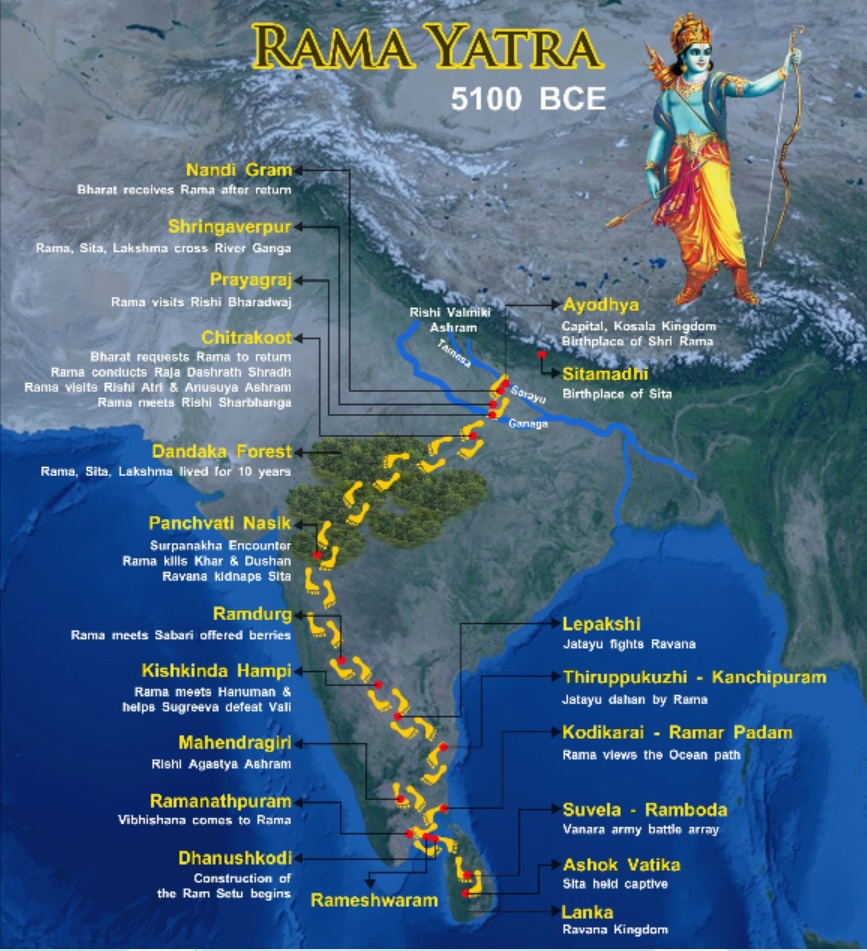
They also lie in the same direction as mentioned in the Ramayana text.
It is interesting to note that these sites are lined from North to South commemorating the events of Ramayana in a progressive manner in the same sequence as they unfolded in the Ramayana narrative too.
For instance, the Dandakaranya forest sites do not lie to the north of Ayodhya or to the south of Kishkinda or close to Rameshwaram. Or for that matter, sites connected with events at Kishkinda are not to be found in say, the hills of Girnar or Jharkhand.
It does not seem plausible that in those remote days, an author would have travelled far and wide to each of those remote places including dense forests and hills to concoct a geographically credible story and build it into local folklore at each of those remote places.
It is also not possible for people across the length of Bharat to have jointly planned to identify and arrange these geographical sites in the chronological order of Ramayana.
These sites have come to be so, since Sri Rama traversed this path.
Many of these names can be found to have continued through the Mahabharata and subsequent periods too, till date.
This tradition of names and locations of places in itself provides the proof for the historical and geographical nature of Sri Rama’s lifestory and connects all these places through this cohesive thread of timeline.
Temples As Blueprints
Many places visited by Sri Rama still retain memories of His life. They are still identifiable and have continuing traditions in the form of temples with legends or folklore to commemorate Rama’s visit or events of His lifetime.
These temples can be classified as:
- Temples celebrating Sri Rama by commemorating specific events that happened there, such as
- Temple at Ayodhya celebrating the birth of Sri Rama and His brothers
- Rama Sita Vivaha Temple at Janakpur celebrating His marriage to Sita Devi
- Temples for Sri Rama, Lakshmana and Sita Devi at Chitrakoot and Panchavati, Nasik, where they were together during most part of their 14years exile
- Temple for Jatayu’s takeoff at Lepakshi in Andhra
- Temple for Jatayu Dahan by Sri Rama in Tiruputkuzhi, near Kanchipuram, Tamil Nadu, which is south east of Lepakshi
- Temple for Sri Rama alone at Tirupullani by the sea near Rameshwaram in Tamil Nadu, where He underwent Tapas without food, lying on a bed of Darbha/Kusha grass for 3 nights to find a way to cross the sea
- Rameshwaram temple where Sri Rama with Sita Devi performed pooja for Shiva Linga after His victory over Ravana
- Devaprayag in the Himalaya where Sri Rama atoned for having killed Ravana and many others in the battle at Lanka
- Etc.
- Temples celebrating Sri Rama by commemorating overall aspects of Sri Rama or some of the important events in His life such as His birth, His marriage, His coronation etc. including some that commemorate His walking into the Sarayu river at the end of His avatar. These are spread all over the land of Bharat.
We find a convergence of literature, geography, folklore, devotion and local tradition in these places.
Imprints on Memory and Culture
There are many great men with impeccable character across the history of the world – personages that one can call as Gunavaan. There are also many victorious Kings across the world who have won great battles.
Why does Sri Rama alone stand out amongst many the Divinities and the many Avatara, as a personage with the epithet Maryada Purushottam, the ultimate in respectfulness?
What has made Him stand out and be continuously revered even across 7 millennia?
However, this is not a question that has come up today. It is a similar question that was asked of Narada by Acharya Ratnakar i.e Maharishi Valmiki, over 7100 years ago too. His question was –
“Was there someone on earth who had exemplified all characteristics that any human can ever bear?”.
Out of this question emerged the answer that it was Sri Rama, who was living then, who possessed all such 16 possible Guna.
It is to bring out these 16 Guna that Acharya Ratnakar started penning the Ramayana as a Itihasa, history in a poetic form.
It is for this, that Acharya Ratnakar got the epithet Adi Kavi, meaning the early poet.
This shows that over 7 Millennia ago itself we have had a personage in Sri Rama, who brought out and showcased to the people, these 16 Guna, through His deeds.
It is this, which makes Him a civilizational hero, a civilization forebearer at a very early stage of our civilizational history and timeline.
This personage, who exemplified all these Guna, gave rich content for authors in every Indian language to bring forth His Guna in their local lands, for their people, in their languages, for their times.
This was not the case within India alone, but also has spread all over S.E.Asia and Asia too.
Sri Rama has been such a reservoir of content for this much narration and depiction due to the innate richness in His personality, the innate content in His life deeds and values in it for emulation too.
In a way, He has borne an apt name Rama too, which means one who radiates charm, one who draws everyone’s attention, one who is pleasing to all (ramya).
Authors, Artists and Storytellers have found content in Him and His life.
Audiences have found value in Him and His Guna. Each found atleast a Guna also to relate to – be it a King, a Rishi, a soldier, a householder.
Bharat has been fortunate to have had the presence of such a personage so early in its history, that it has propelled it in its upholding of being a Dharmic land.
Sri Rama – Role Model for Connecting Dharma and Guna
In Dharma, it is Guna that plays an important role. Guna and Dharma are naturally intertwined.
This can be inferred from the very word “Dharma” which bears the root Dhara, meaning the nature to bear, to carry. And, that, which is most naturally and effortlessly carried or borne, is one’s own innate trait, Guna.
Dharma denotes the innate nature with which, one is expected to exist, behave or conduct oneself.
For instance, it is a Tiger’s Dharma to be carnivorous, kill and eat other animals and this is exhibited through its Guna of strength, speed and ferociousness besides its physical bodily attributes such as claws, teeth and strong legs.
Likewise, it is Sun’s Dharma to be a star and hold planets together, making them go around it as a Solar system and this is exhibited through its Guna of shining, radiating heat and being massive enough to exercise the pull of gravity over the planets.
With more evolved beings such as mankind, that have a more evolved mind (Mana), intellect (Buddhi) and sense of identity (Ahankara), Dharma or innate and expected conduct also takes on varied hues depending on context and relations.
Dharma therefore, manifests through the Guna that every entity can exhibit in reaction, in context to relations and responses to events. It is these reactions which go to shape the ultimate cause and effect chain, Karma that propels Creation, making it evolve every instant accordingly. This is the Dharma of Srishti, Creation too.
Dharma is thus the order in the Universe, from the Guna in the Universe, that makes the Universe behave and exist the way it does.
In Guna, there are 16 Guna that people aspire to live up to, work towards. But amongst all personages in history, there is only one personage to whom all these 16 Guna have been ascribed without doubt, without hesitation. That is Sri Rama and He has therefore been addressed as Maryada Purushottam.
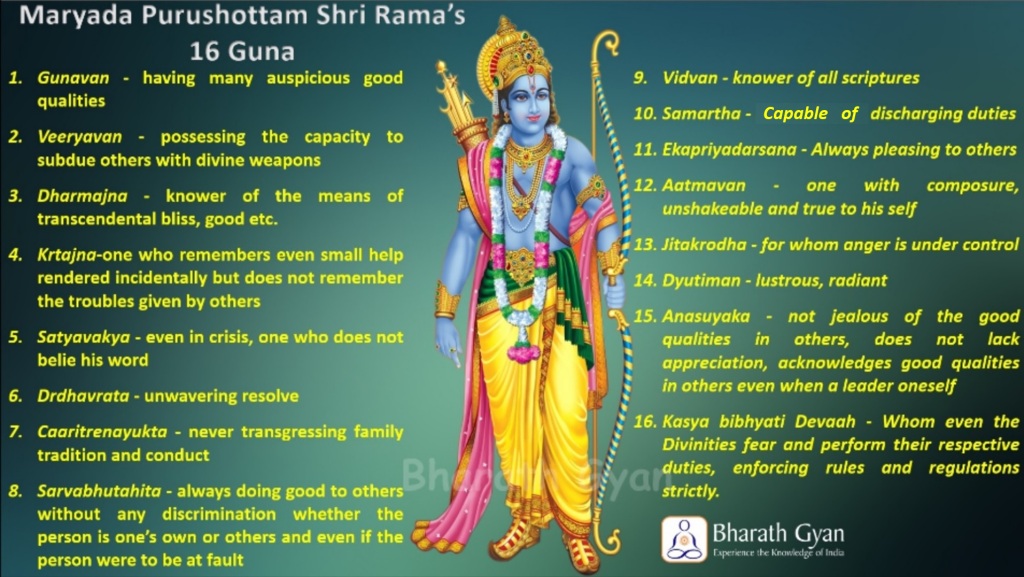
Sri Rama, through His life has relied on and showcased each of these Guna, as He went about His Dharma in the various roles of a son, a brother, a student, a Prince, a husband, an exile, a warrior, a King, a father etc. Without these Guna, He could not have adhered to His Dharma and behaved as such.
Maryadha Purushottam Rama, the torchbearer of the 16 possible Guna that a human can conduct himself by, hence, also exemplifies the intertwined bridge between Dharma and Guna in each and every one of us.
It is this innate connect between Dharma and Guna, with Sri Rama as a role model for the same, which has connected Sri Rama to everyone across Bharat and across the world too. It has kept Sri Rama relevant to the people of Bharat even across millennia.
Another visual reminder of such an intertwined connect between Dharma and Guna can be seen in the 24 spoked Chakra at the centre of India’s national flag.
This wheel, called the Dharma Chakra, stands for the 24 Dos and Don’ts to be practiced, as one journeys through one’s life in alignment with Dharma.
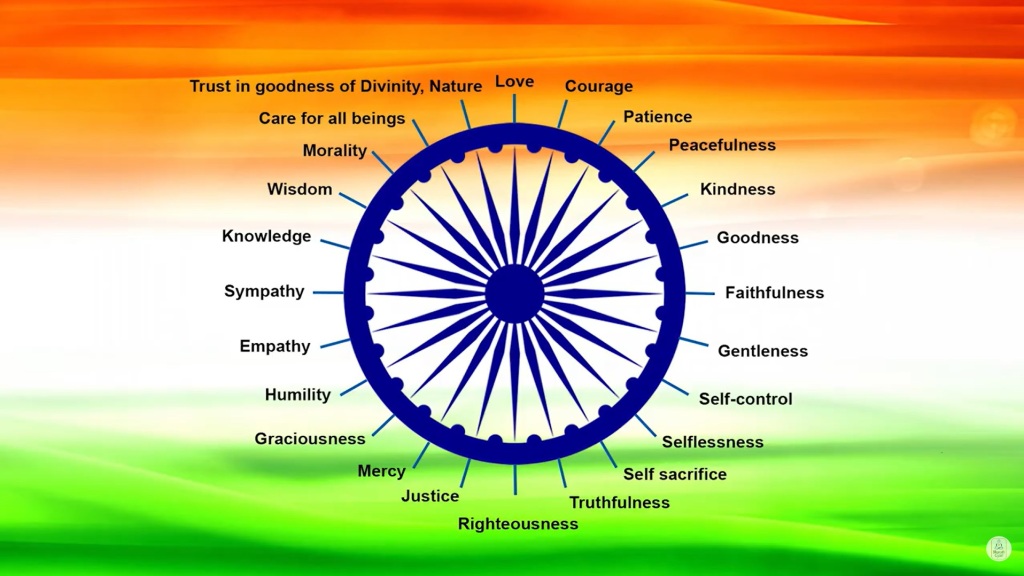
It is this sublime aspect of Sri Rama showcasing a bridge between Dharma and Guna, which has provided inspiration and content to so many poets, Kavi and artists, to convey as the essence of good conduct and moral values for generations.
And, with each generation finding their own way to narrate and depict Sri Rama and His Ramayana, not only have they kept their bond with Sri Rama alive, they have also kept reemphasizing this connect between Dharma and the Guna with which we live.
Sri Rama and His Ramayana have thus been keeping Bharat connected through its Geography, History, Traditions, Values and Dharma for millennia.
The new temple at Ayodhya for Sri Rama will now ensure that this bandhan will continue for generations to come in future too!
New India is aspirational. It aspires as a nation for different aspects such as:
- Economical well being
- Good infrastructure
- Good Governance etc.
Apart from all this, one of the other aspirations at an individual level is also to ensure that each individual lives with good Guna, good character. The template, as well as role model for these aspirations comes in the form of Sri Rama with all His 16 Guna.
Sri Rama is truly an inspirational hero for inspirational India.
Sri Rama continues to show us how he has bridged lands across the seas, places across the land, people across generations and values across ages too!

